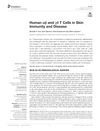Detection of Subtypes of T Helper Cells and Their Cytokines in Peripheral Blood of Patients with Systemic Lupus Erythematosus and Their Clinical Significances
January 2014
in “
Journal of Jilin University
”
TLDR Higher levels of certain immune cells and proteins are linked to more severe lupus symptoms.
The study investigated the changes and clinical significance of T helper cell subtypes (Th22, Th17, and Th1) and their cytokines in the peripheral blood of 30 patients with systemic lupus erythematosus (SLE) compared to 30 healthy controls. It found that the ratios of Th22, Th17, and IL-22+Th1 cells, as well as the levels of plasma IL-22 and IL-17, were significantly higher in SLE patients. There was a positive correlation between Th17 and Th22 cell ratios and between Th22 cell ratios and plasma IL-22 levels. Increased ratios of IL-22+CD4+T and IL-22-Th17 cells correlated with higher disease activity scores. Th22 cell ratios were higher in patients with facial erythema, hair loss, and positive anti-nuclear antibody (ANA), while Th17 cell ratios were higher in patients with light allergies or positive anti-dsDNA. The study concluded that IL-22+CD4+T cells, particularly Th22 cells and their cytokine IL-22, played a crucial role in SLE pathogenesis and could serve as biomarkers for disease severity.


